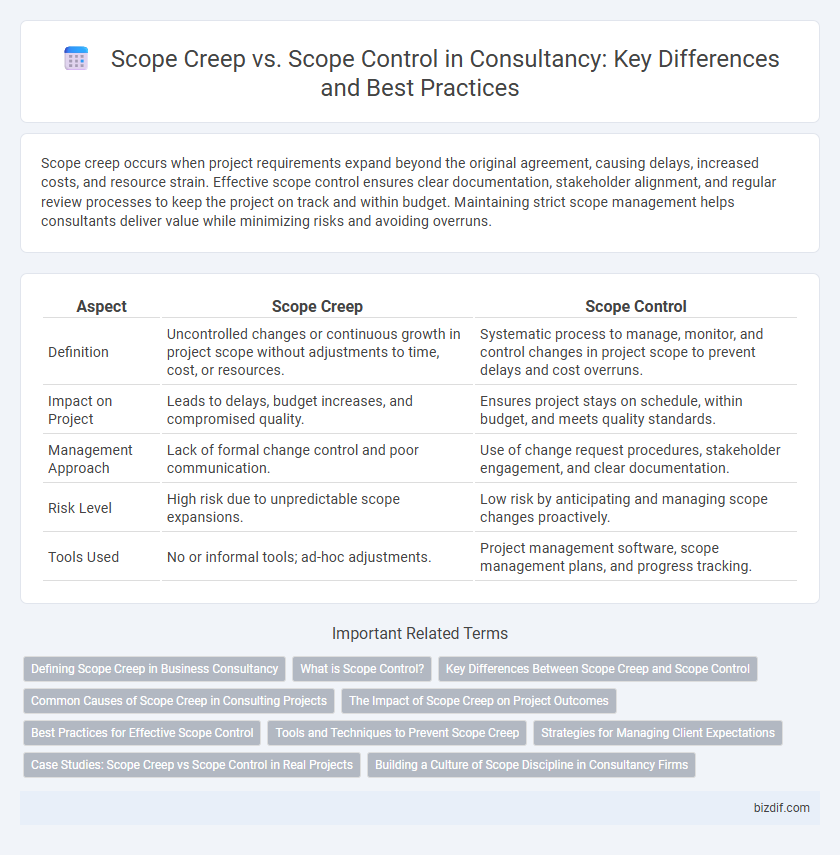Scope creep occurs when project requirements expand beyond the original agreement, causing delays, increased costs, and resource strain. Effective scope control ensures clear documentation, stakeholder alignment, and regular review processes to keep the project on track and within budget. Maintaining strict scope management helps consultants deliver value while minimizing risks and avoiding overruns.
Table of Comparison
| Aspect | Scope Creep | Scope Control |
|---|---|---|
| Definition | Uncontrolled changes or continuous growth in project scope without adjustments to time, cost, or resources. | Systematic process to manage, monitor, and control changes in project scope to prevent delays and cost overruns. |
| Impact on Project | Leads to delays, budget increases, and compromised quality. | Ensures project stays on schedule, within budget, and meets quality standards. |
| Management Approach | Lack of formal change control and poor communication. | Use of change request procedures, stakeholder engagement, and clear documentation. |
| Risk Level | High risk due to unpredictable scope expansions. | Low risk by anticipating and managing scope changes proactively. |
| Tools Used | No or informal tools; ad-hoc adjustments. | Project management software, scope management plans, and progress tracking. |
Defining Scope Creep in Business Consultancy
Scope creep in business consultancy refers to the uncontrolled expansion or shift in project deliverables without corresponding adjustments in resources, timeline, or budget. It often results from unclear project objectives, inadequate initial requirements gathering, or client-driven changes that lack formal approval. Effective scope control mechanisms, such as detailed project charters and change management processes, are essential to prevent scope creep and maintain project success.
What is Scope Control?
Scope control is the process of managing and regulating project scope to prevent scope creep, ensuring that project objectives and deliverables remain aligned with initial plans. It involves continuous monitoring, documentation, and approval of any changes to the project scope through formal change control processes. Effective scope control enhances project success by minimizing risks of budget overruns, timeline delays, and resource misallocation.
Key Differences Between Scope Creep and Scope Control
Scope creep refers to the uncontrolled expansion of a project's objectives, deliverables, or tasks beyond the original plan, often leading to missed deadlines and budget overruns. Scope control involves proactive management techniques such as clear requirement documentation, change request processes, and stakeholder communication to maintain project boundaries and ensure objectives are met. The key difference lies in scope creep representing unplanned deviations, while scope control enforces structured adjustments to keep the project aligned with its goals.
Common Causes of Scope Creep in Consulting Projects
Common causes of scope creep in consulting projects include unclear project objectives, evolving client requirements, and inadequate stakeholder communication. Frequent changes in project deliverables arise from ambiguous initial scope definitions and lack of formal change control processes. Effective scope control relies on well-defined project boundaries and proactive management of client expectations throughout the consultancy engagement.
The Impact of Scope Creep on Project Outcomes
Scope creep significantly undermines project outcomes by introducing unplanned tasks that extend timelines and inflate budgets, often leading to resource strain and compromised quality. Unmanaged scope changes can derail objectives, causing missed deadlines and diminishing stakeholder satisfaction. Effective scope control aligns project deliverables with original goals, ensuring predictable performance and successful completion.
Best Practices for Effective Scope Control
Effective scope control in consultancy hinges on clearly defining project deliverables, establishing transparent communication channels, and implementing robust change management processes. Utilizing project management tools like Gantt charts and requirement traceability matrices helps maintain alignment between client expectations and project progress. Regular stakeholder reviews and documented approval workflows prevent scope creep, ensuring project objectives are met within time and budget constraints.
Tools and Techniques to Prevent Scope Creep
Effective scope control relies on tools like Work Breakdown Structures (WBS) and project management software that define and monitor project deliverables clearly. Techniques such as Change Control Boards (CCB) and regular stakeholder communication help manage scope changes and prevent scope creep by ensuring all modifications are formally evaluated and approved. Utilizing these tools and structured processes supports maintaining project objectives and timelines without unplanned expansions.
Strategies for Managing Client Expectations
Effective management of client expectations in consultancy requires clear communication of project scope boundaries and deliverables to prevent scope creep. Implementing formal change control processes ensures that any modifications are documented, evaluated for impact, and approved before execution. Regular status updates and stakeholder engagement maintain transparency and reinforce scope control, leading to successful project outcomes.
Case Studies: Scope Creep vs Scope Control in Real Projects
Case studies in consultancy reveal that scope creep frequently results in extended timelines and inflated budgets, often due to poorly defined project boundaries and stakeholder demands. Effective scope control techniques, such as stringent change management processes and clear communication protocols, consistently lead to successful project delivery within original constraints. Empirical data from multiple real projects demonstrate that proactive scope management reduces project overruns by up to 40%, highlighting the critical importance of disciplined scope control in consultancy.
Building a Culture of Scope Discipline in Consultancy Firms
Building a culture of scope discipline in consultancy firms requires clear project definitions and rigorous change management processes to prevent scope creep. Emphasizing accountability, consistent client communication, and detailed documentation ensures that project deliverables align with agreed objectives. Training consultants on scope control techniques fosters a proactive approach to managing expectations and maintaining project focus.
Scope Creep vs Scope Control Infographic

 bizdif.com
bizdif.com